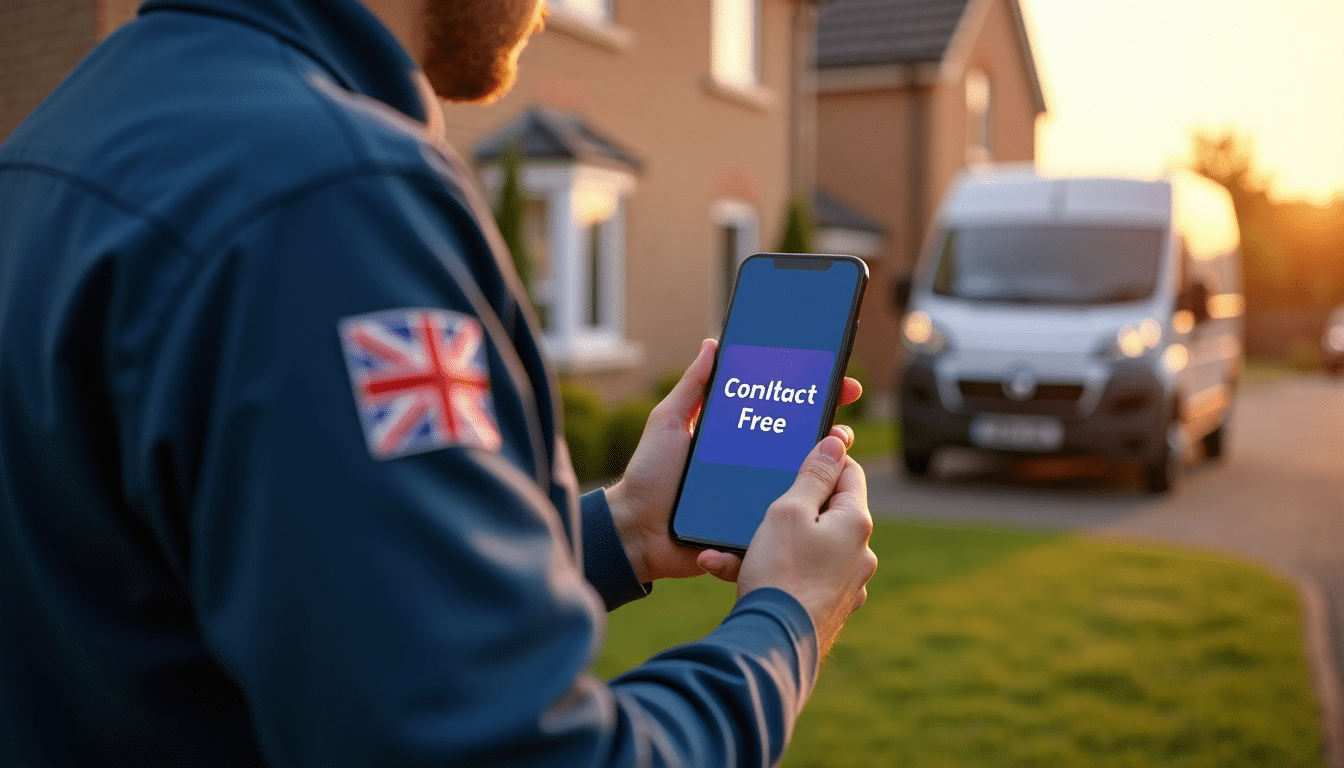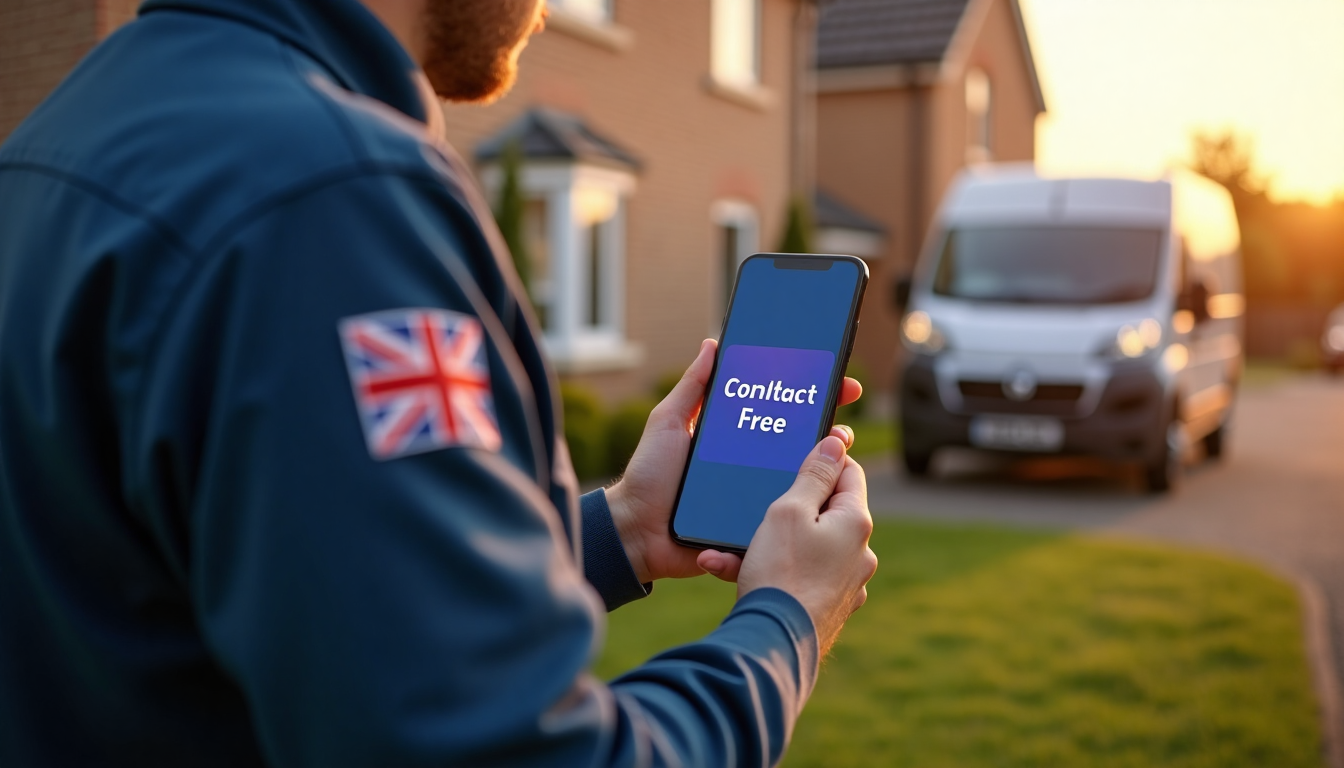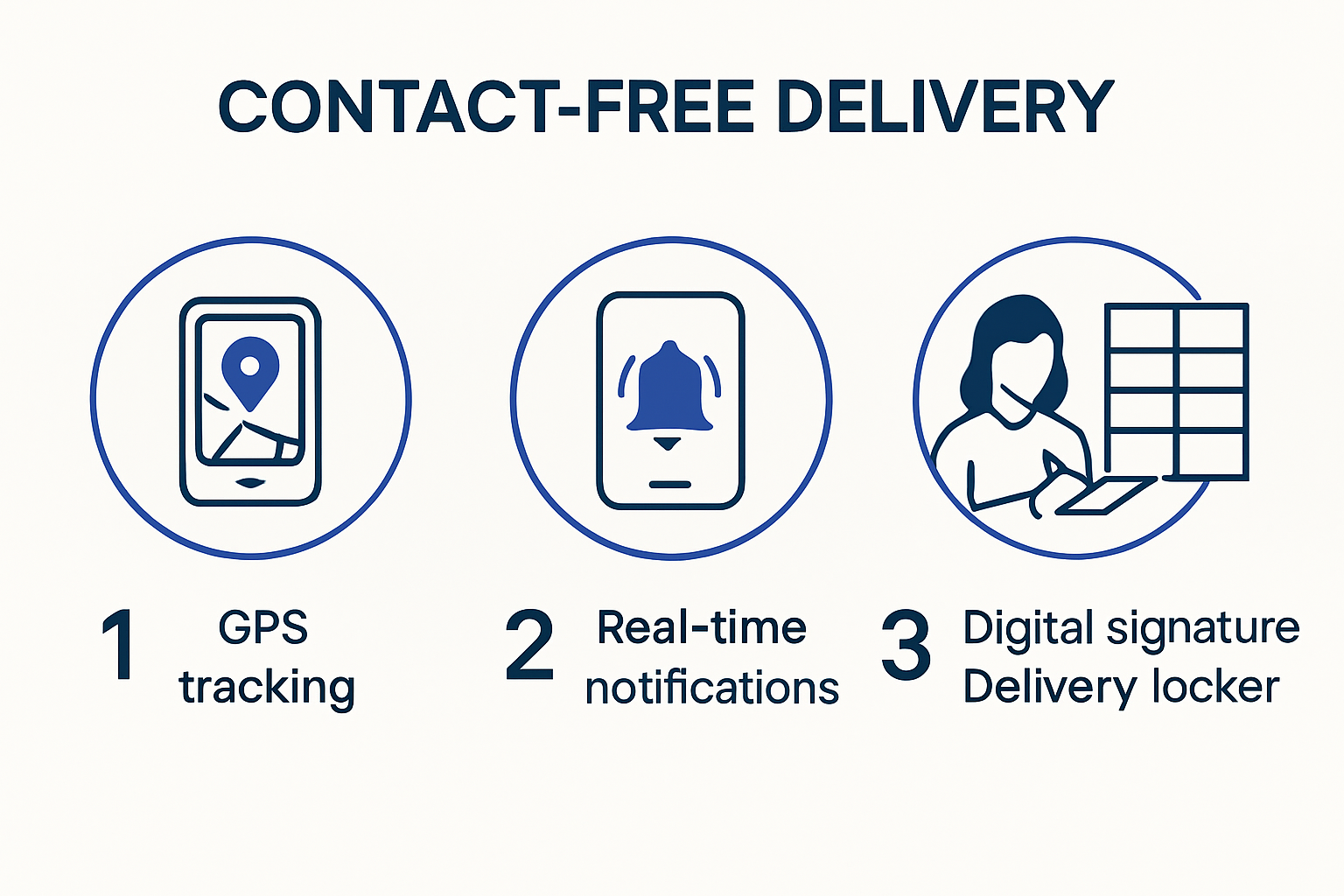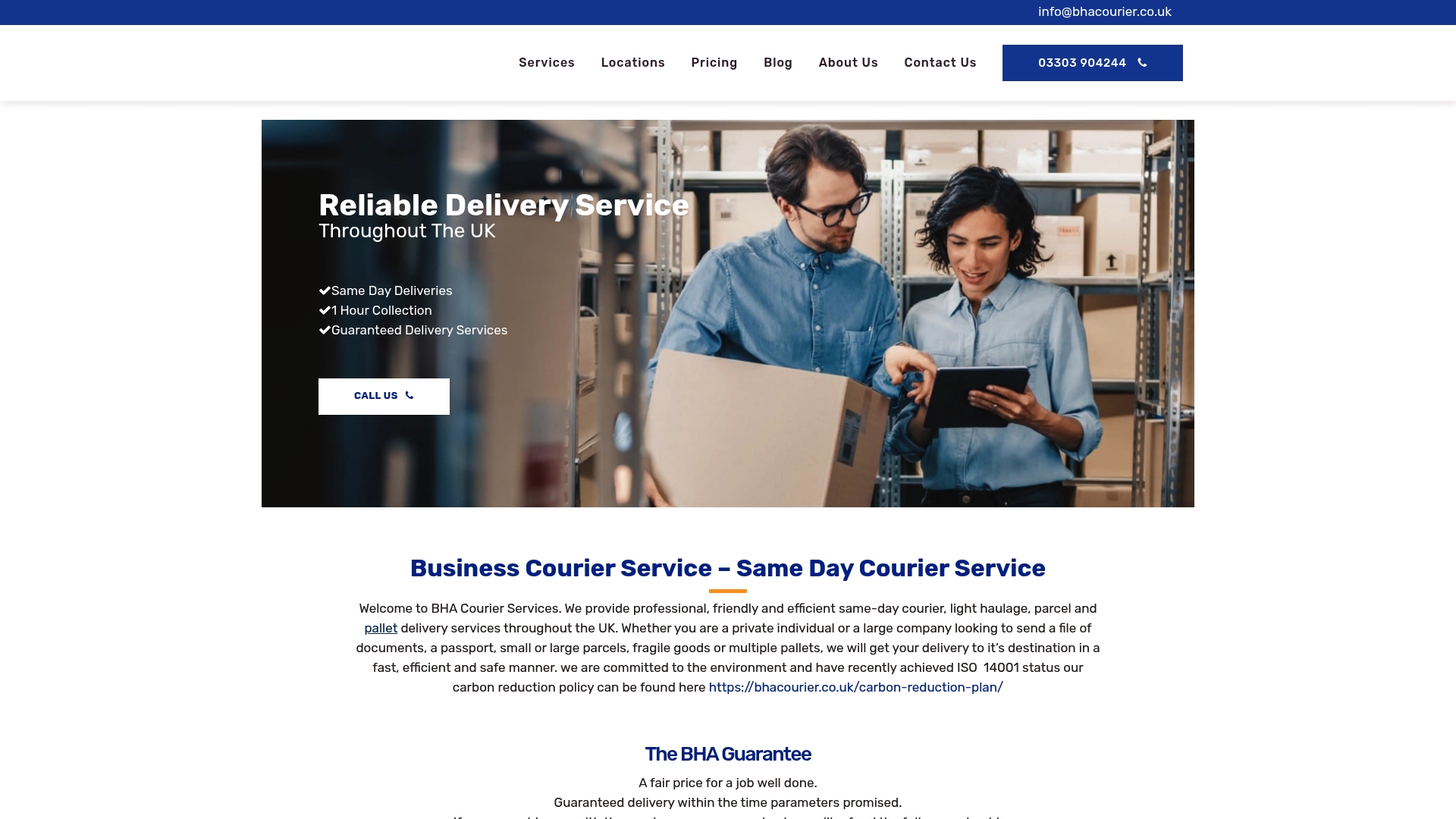
10 Jul Contact Free Delivery in the UK: The 2025 Guide for Businesses

Contact free delivery is reshaping how businesses across the UK interact with customers, streamlining operations and responding to new safety expectations. Here is something few companies realise. Businesses using advanced contact free delivery tech can cut delivery costs by up to 20 percent while also lifting customer loyalty rates by as much as 25 percent. These gains are not just about swapping a handshake for a doorstep drop. They reveal a competitive edge hiding in plain sight, waiting for smart firms to claim it.
Table of Contents
- Understanding Contact Free Delivery Methods
- Benefits For UK Businesses And E-Commerce
- Implementing Contact Free Delivery In Your Operations
- Best Practices For Safe And Timely Deliveries
Quick Summary
| Takeaway | Explanation |
|---|---|
| Embrace Advanced Technologies | Businesses should invest in technologies like GPS tracking, real-time notifications, and automated delivery systems to enhance transparency and security in contact free delivery operations. |
| Prioritise Customer Trust | Building customer trust is crucial; companies must ensure reliable tracking systems and transparent communication regarding delivery processes to meet modern consumer expectations. |
| Implement Comprehensive Policies | Developing detailed delivery policies that clearly outline expectations and potential limitations can help manage customer expectations and reduce misunderstandings. |
| Facilitate Digital Accessibility | Ensuring that digital systems are user-friendly and accessible to all customers is vital for inclusivity and satisfaction in contact free delivery. |
| Adopt Proactive Risk Management | Businesses must implement robust risk management strategies, including quality control and insurance coverage, to safeguard operations and enhance customer confidence. |
Understanding Contact Free Delivery Methods
Contact free delivery has rapidly transformed from a temporary pandemic solution to a permanent business strategy for companies across the United Kingdom. This method of delivery prioritises customer safety, convenience, and efficiency by minimising direct human interaction during package transportation and receipt.
The Evolution of Contact Free Delivery Technologies
The concept of contact free delivery emerged as a critical response to public health challenges during the COVID-19 pandemic. NHS England’s Community Pharmacy Home Delivery Service demonstrated how essential services could adapt quickly to ensure vulnerable populations received critical supplies without personal contact.
Modern contact free delivery methods now incorporate sophisticated technologies that go beyond simple no-contact drop-offs. These include GPS tracking, real-time notifications, secure digital signatures, and automated delivery lockers. Businesses are investing in these technologies to provide customers with transparent, secure, and convenient delivery experiences.

Key Components of Effective Contact Free Delivery Systems
Successful contact free delivery relies on several critical components. Digital tracking allows customers to monitor their package’s journey in real time. Secure drop-off points such as smart lockers or designated safe locations eliminate the need for direct interaction. Royal Mail’s prescription delivery service exemplifies how technology can streamline delivery processes while maintaining customer privacy and convenience.
The **NHS Supply Chain’s Home Delivery Service](https://www.supplychain.nhs.uk/customer-service/home-delivery-service/) further illustrates the potential of contact free delivery, particularly in sensitive sectors like healthcare. By enabling direct delivery of medical supplies to patients’ homes, these services demonstrate how contact free methods can enhance accessibility and reduce logistical barriers.
Security and Customer Trust in Contact Free Delivery

Implementing contact free delivery is not just about avoiding physical interaction. It is about building customer trust through reliable, transparent, and secure delivery processes. Businesses must invest in robust digital infrastructure, clear communication protocols, and dependable tracking systems.
Customers now expect delivery methods that offer flexibility, speed, and minimal personal interaction. This means companies must design delivery solutions that are not only technologically advanced but also user-friendly and adaptable to diverse customer needs. The future of delivery is not just about moving packages from point A to point B, but creating a seamless, secure, and convenient experience that meets the evolving expectations of modern consumers.
As businesses continue to refine their contact free delivery strategies, the focus remains on leveraging technology to create efficient, safe, and customer-centric delivery solutions that respond to changing market demands and consumer preferences.
Benefits for UK Businesses and E-Commerce
Contact free delivery has emerged as a transformative strategy for UK businesses, particularly in the e-commerce sector, offering substantial advantages that extend far beyond pandemic-era emergency solutions. By integrating sophisticated delivery methods, companies can significantly enhance operational efficiency, customer satisfaction, and competitive positioning.
Cost Efficiency and Operational Optimization
Businesses adopting contact free delivery methods can achieve remarkable cost savings and operational improvements. Research from ShipScience indicates that companies can reduce overall delivery costs by up to 20% through streamlined processes. These savings stem from minimised manual handling, reduced need for personal protective equipment, and more efficient logistics management.
The efficiency gains are particularly pronounced for e-commerce platforms. Automated delivery systems reduce human intervention, decrease error rates, and enable faster package processing. Companies can reallocate resources previously spent on traditional delivery methods towards innovation and customer experience enhancement.
Enhanced Customer Experience and Retention
Customer expectations have fundamentally shifted, with convenience and safety becoming paramount considerations in purchasing decisions. BigBlue research highlights that contactless delivery services can dramatically improve customer satisfaction by providing greater flexibility and reducing package loss or theft risks.
Moreover, businesses implementing comprehensive contact free delivery strategies have witnessed significant customer retention improvements. Studies demonstrate a potential 25% increase in customer loyalty during the pandemic for companies offering sophisticated contactless delivery options. This retention translates directly into sustained revenue and improved long-term business performance.
Strategic Competitive Advantage
In the rapidly evolving UK business landscape, contact free delivery has transitioned from a temporary solution to a strategic differentiator. Companies that invest in advanced delivery technologies position themselves as innovative, customer-centric organisations. Learn more about our specialised delivery services for businesses seeking comprehensive logistics solutions.
The competitive advantages extend beyond immediate operational benefits. Businesses demonstrating adaptability, technological proficiency, and customer-first approaches are more likely to attract modern consumers who value convenience, safety, and technological integration. Contact free delivery represents not just a logistical strategy, but a powerful statement about a company’s commitment to meeting contemporary consumer needs.
As the UK business ecosystem continues to evolve, contact free delivery will remain a critical component of successful e-commerce and logistics strategies. Companies that embrace these technologies will be best positioned to thrive in an increasingly digital and safety-conscious marketplace.
To help visualise the main business benefits discussed above, the following table organises the key advantages of contact free delivery for UK businesses and e-commerce:
| Benefit | Description | Example/Impact |
|---|---|---|
| Cost Savings | Reduce delivery costs by up to 20% through efficient processes | Lower manual handling and PPE expenses |
| Operational Efficiency | Streamlined logistics and automation reduce errors and delays | Quicker package processing, fewer mistakes |
| Enhanced Customer Experience | Greater convenience and flexibility for customers | Real-time tracking, safer deliveries |
| Increased Customer Retention | Up to 25% boost in loyalty for firms with contactless options | Sustained revenue, improved long-term performance |
| Competitive Differentiation | Positions business as innovative and customer-focused | Attracts tech-savvy, safety-conscious consumers |
Implementing Contact Free Delivery in Your Operations
Transitioning to contact free delivery requires strategic planning, technological investment, and a comprehensive understanding of operational requirements. UK businesses must approach this implementation systematically to ensure seamless integration and maximise potential benefits.
Digital Infrastructure and Technology Adoption
Successful contact free delivery begins with robust digital infrastructure. NHS England’s National Commercial and Procurement Hub provides valuable insights into digital transformation strategies that can be adapted across various sectors. Businesses should focus on developing technological capabilities that support end-to-end digital delivery processes.
Key technological components include:
- Advanced GPS tracking systems
- Real-time notification platforms
- Secure digital signature technologies
- Automated delivery management software
Investing in cloud-based solutions enables greater flexibility and scalability. The UK government’s consultation on electronic invoicing emphasises the importance of secure digital data exchange, which directly applies to contact free delivery implementation.
Operational Process Redesign
Implementing contact free delivery requires fundamental redesign of existing operational processes. This involves creating new workflows that prioritise minimal human interaction while maintaining high service standards. The NHS Supply Chain’s Digital Commerce Programme offers an excellent model for digital transformation across complex operational environments.
Businesses should consider:
- Mapping current delivery processes
- Identifying potential touchpoints for digital intervention
- Developing standard operating procedures for contact free delivery
- Training staff on new technological systems
To clarify the practical steps outlined in this section, the following table summarises the key stages for implementing contact free delivery in UK businesses:
| Implementation Stage | Key Actions | Purpose/Goal |
|---|---|---|
| Assess Current Operations | Map delivery processes; identify manual touchpoints | Establish baseline and improvement areas |
| Upgrade Digital Infrastructure | Adopt GPS, real-time notifications, digital signatures | Enable seamless, tech-driven delivery |
| Redesign Workflows | Create procedures minimising human contact | Increase safety and process efficiency |
| Staff Training | Educate employees on new tech and protocols | Empower staff for smooth transition |
| Monitor & Optimise | Perform regular audits; gather feedback | Ensure quality, compliance, improvements |
Risk Management and Compliance
Contact free delivery introduces new operational risks that must be carefully managed. Businesses need comprehensive strategies addressing data security, package integrity, and customer verification. This involves implementing multi-layered verification processes, secure drop-off protocols, and transparent tracking mechanisms.
Customer communication becomes crucial in this context. Clear communication about delivery processes, tracking capabilities, and safety measures helps build trust and manage expectations. Learn more about our secure delivery protocols for businesses seeking comprehensive logistics solutions.
Compliance with data protection regulations, such as GDPR, is paramount. Each digital interaction must be designed with privacy and security in mind. Businesses should conduct regular audits of their digital delivery systems to ensure ongoing compliance and identify potential vulnerabilities.
The transition to contact free delivery is not a one-time project but an ongoing journey of technological adaptation and operational refinement. By approaching implementation strategically, investing in robust technologies, and maintaining a customer-centric perspective, UK businesses can successfully navigate this critical transformation in delivery services.
Best Practices for Safe and Timely Deliveries
Delivery services in the UK must prioritise safety, efficiency, and customer satisfaction in an increasingly digital and complex logistical landscape. Implementing robust best practices ensures consistent, reliable, and professional delivery experiences across various business sectors.
Comprehensive Delivery Policy and Transparency
The UK government’s Parcel Deliveries: Best Practice Guide emphasises the critical importance of clear and transparent delivery policies. Businesses should develop comprehensive guidelines that clearly communicate delivery expectations, potential limitations, and customer protections.
Key elements of a robust delivery policy include:
- Precise delivery time windows
- Clear communication protocols
- Transparent pricing structures
- Explicit package handling procedures
Transparency builds customer trust and reduces potential misunderstandings. By providing detailed information upfront, businesses can manage customer expectations and minimize potential service disputes.
Digital Accessibility and Inclusive Service Design
Ensuring digital services are accessible to all customers is paramount. The NHS Digital Service Manual recommends meeting Web Content Accessibility Guidelines (WCAG) 2.2 to create inclusive delivery experiences. This approach ensures that delivery tracking, booking, and communication systems are usable by individuals with diverse technological capabilities and accessibility needs.
Businesses should focus on:
- Developing user-friendly digital interfaces
- Providing multiple communication channels
- Offering alternative delivery confirmation methods
- Supporting customers with varying technological proficiencies
Risk Management and Quality Assurance
Effective contact free delivery requires robust risk management strategies. This involves implementing comprehensive insurance coverage, developing strict quality control protocols, and maintaining detailed tracking mechanisms. Learn more about courier insurance requirements to understand the critical protective measures businesses must consider.
Risk management strategies should include:
- Detailed package tracking
- Secure delivery verification processes
- Comprehensive insurance coverage
- Regular performance audits
By adopting a proactive approach to risk management, businesses can protect both their operational interests and customer investments. This involves continuous monitoring, swift problem resolution, and maintaining high standards of service quality.
Successful contact free delivery is not just about technological implementation but about creating a holistic, customer-centric approach that prioritises safety, efficiency, and reliability. Businesses that invest in comprehensive policies, accessible digital systems, and robust risk management will distinguish themselves in an increasingly competitive delivery marketplace.
Frequently Asked Questions
What is contact free delivery?
Contact free delivery is a method that minimises direct human interaction during package transportation and receipt, prioritising customer safety and convenience.
How does contact free delivery save businesses money?
Businesses can reduce delivery costs by up to 20% through streamlined processes and minimised manual handling, allowing better resource allocation and efficiency.
What technologies are used in contact free delivery?
Key technologies include GPS tracking, real-time notifications, secure digital signatures, and automated delivery management systems, all aimed at enhancing transparency and customer experience.
How can businesses build customer trust with contact free delivery?
Building customer trust involves implementing reliable tracking systems, clear communication about delivery processes, and transparent policies to manage expectations effectively.
Turn Contact Free Delivery Challenges Into Lasting Business Gains
Modern UK businesses cannot afford to underestimate the impact of secure, efficient contact free delivery. The article highlights the real pain of outdated logistics: excessive costs, customer trust gaps, and the struggle to meet new digital expectations. If your team is finding it hard to cut delivery expenses while guaranteeing speed and safety, you are not alone. Staying competitive in 2025 means more than improvising—it means partnering with specialists who are already ahead.

Choose a courier solution that adapts to your needs today. With BHA Courier, experience industry-leading same-day and next-day contact free delivery across the UK, all while benefiting from advanced tracking and total security for your critical packages. Explore our secure delivery services for sensitive documents or jump straight to BHA Courier to book your next delivery and discover why businesses nationwide trust us. Ensure your operations never fall behind—act now so your customers always feel safe and valued.
Recommended
- Business Courier Service – Same Day Courier Service – BHA Couriers
- BHA Couriers BHA Couriers Blog – Same Day Delivery Across The UK
- What Insurance Do Couriers Need? A Comprehensive Guide – BHA Couriers
- BHA Couriers South West | Dedicated Delivery
- Emergency Courier Service for Keys – BHA Couriers
- BHA Couriers Wales | Dedicated Delivery

Sorry, the comment form is closed at this time.